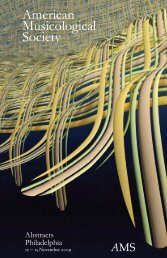Abstracts - American Musicological Society
Abstracts - American Musicological Society
Abstracts - American Musicological Society
You also want an ePaper? Increase the reach of your titles
YUMPU automatically turns print PDFs into web optimized ePapers that Google loves.
ThursdaY afternoon<br />
that of the thematic surface, saturating the texture<br />
without being confined to nornal processes of rnotivic<br />
transformation and thematic development.<br />
Applied to the whole of the quartet, this insight<br />
illuminates a design that focuses on shifting<br />
inflectional tensions within one element of this<br />
"subthematic" configuration: the f-e half-step first<br />
presented in the opening measures of the first<br />
movement. Within this design, the precarious tonal<br />
modal balance of the Dankgesang emerges as a node of<br />
extreme ambiguity in which any sense of a stable<br />
inflectional relation between f and e is completely<br />
obscured, generating tensions that spill over into the<br />
follovring movements--tensions for which no normal<br />
process of resolution seems appropriate.<br />
SCHUMANN AND<br />
R. Larry Todd, Duke<br />
BRUCKNER<br />
Univers ity, Chair<br />
SCHUMANN'S IM LEGENDENTON<br />
AND FRIEDRICH SCHLEGEL'S ARABESKE<br />
John J. Daverio, Boston Universicy<br />
The writings of Friedrich Schlegel, perhaps the<br />
chief early romantic critic/philosopher, have received<br />
little attention frorn musical scholars. While music did<br />
not much figure in SchIegeL's romantic programme (he<br />
was indeed a litcle suspicious of it), there are<br />
numerous aspects of his literary theory that are useful<br />
in assessing the more disruptive qualities of<br />
nineteenth-century musical form. This paper examines<br />
the concept that was at the heart of Schlegel's<br />
critical theory: the Arabeske (arabesque), a notion<br />
developed principally in his "GesprSch riber die poesie"<br />
(L799) and Atheneum Fragmenre (I797 /99) . In a limired<br />
sense, the arabesque refers to digressive<br />
interpoLations that intentionally disturl<br />
chronological<br />
the<br />
flow of a typical narrative; as<br />
form,<br />
a total<br />
the arabesque tempers a seemingly<br />
diversity through a deliberately .or,"""1"d "h"oti.<br />
process.<br />
logicat<br />
rhis rwof old principle is<br />
:: 'fJ-.". *1.*:l^".:_1:t:",<br />
::q : :. " ^ :: "*n-.j_.- rh^e f i r s r, *;;;;" ; ; "'# ","";i1"";1i ""' ;<br />
[?:;:","*:E:=+,. of."" 17, -s;;;"rr]' .'".""""r11X.J :<br />
l I :l .'" ff,,:"' : .i," il: ^ -';';. " : ; i' ;' ;:;'" ".'i' form. While<br />
--rnrveE! J rranorlng<br />
most<br />
ot : sonata ::.. :<br />
Leeend.enton /o view<br />
-^r.."11":a:ao1"<br />
the ":"r" cenrral ]n<br />
Hf" .*trtff" . ^,-", i : r r _ ; ; ;;;i o'<br />
" " " .,,t=<br />
subscitute . i I i I o for<br />
u unafakterstlick) .."?",<br />
th<br />
. u"""1,. as ta<br />
close anat-"r. -^-_.^,more. usual d"rulopra.I-"u.tior,, a<br />
11o"."n""".""tJ;.r,1,,:,.:_"^"_i-"'.r.,".""iJ."r"r"..":""01.;.r""....r.r'""r1,r.i<br />
: :. Jr1', .' " i' q i t,'ia t J'-J ; ;; : ; :<br />
" "'"' ;::' "" earlier: i - .il 1;' ; : : : : i : :<br />
____::: H!vLcss Degun some<br />
arabesque rnusical<br />
"a"u""or"'r'--'ir^t"., in .n. ",<br />
"daydream,<br />
1i*i."'i"'"""i'"". ".,ff.."?:;;"r'.: Eures of # the<br />
.i:










